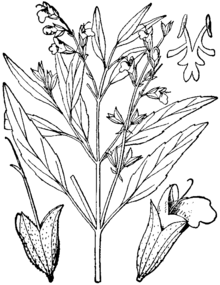Salvia reflexa
| Salvia reflexa | |
|---|---|
 | |
| Scientific classification | |
| Kingdom: | Plantae |
| (unranked): | Angiosperms |
| (unranked): | Eudicots |
| (unranked): | Asterids |
| Order: | Lamiales |
| Family: | Lamiaceae |
| Genus: | Salvia |
| Species: | S. reflexa |
| Binomial name | |
| Salvia reflexa Hornem.[1] | |
Salvia reflexa, the lanceleaf sage,[1] Rocky Mountain sage,[1] blue sage,[1] lambsleaf sage,[1] sage mint[1] or mintweed,[2] is a perennial subshrub native to the United States and Mexico and introduced to Argentina, Australia, Canada, South Africa and New Zealand.[3]
It reaches 4-28 inches (10-71 cm) in height with small, opposite, lanceolate to narrowly elliptic leaves up to two inches (5 cm) long. The flowers grow in whorls, and are pale blue to dark blue and bloom from Summer to Autumn. Salvia reflexa is found in pastures and prairies and can be toxic to cattle, sheep and goats due to its accumulation of nitrates.[4] Poisoning is not common, and reported cases are limited to animals eating contaminated hay. Symptoms of toxicity are muscular weakness, diarrhea, and colic.[5]
References
- 1 2 3 4 5 6 "Salvia reflexa". Natural Resources Conservation Service PLANTS Database. USDA. Retrieved 1 February 2016.
- ↑ "BSBI List 2007". Botanical Society of Britain and Ireland. Archived from the original (xls) on 2015-02-25. Retrieved 2014-10-17.
- ↑ "Salvia reflexa information from NPGS/GRIN". www.ars-grin.gov. Retrieved 2008-06-17.
- ↑ "Kansas Wildflowers and Grasses - Lance-leaf sage". www.kswildflower.org. Retrieved 2010-10-11.
- ↑ "Texas Toxic Plants". Archived from the original on 2006-10-21. Retrieved 2008-06-17.